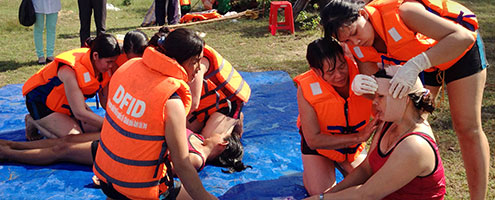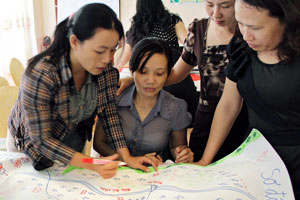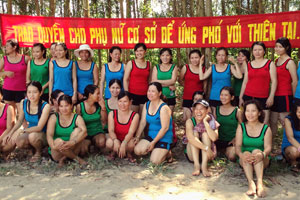Lives saved in Viet Nam by involving women in disaster planning
Through the training of women in disaster management, as well as national lobbying, the contribution of women has been recognized and a government decree now gives the Women’s Union an official space in decision-making bodies.Date:

For millions of people in rural Viet Nam, the impacts of climate change aremounting and sometimes deadly. As weather patterns change, many of Viet Nam’swomen in particular are paying a high price.
“The weather becomes more extreme and erratic. Storms, heavy rains and floodsdestroy fields and houses, kill animals and people every year,” said RanhNguyen, 35, a farmer and the head of the Women's Union group in An Dung commune,in Binh Dinh province, central Viet Nam.
There, Ranh and her neighbours have joined the Viet Nam Women’s Union and areworking with UN Women to strengthen the role of women in disaster risk-reductionand disaster-reduction management.
Some 80 km from the city of Binh Dinh, An Dung commune is always at high riskof flooding as it only has one road connecting it to other communes andlandslides often occur during the storm season. Almost every year, the communesuffers at least one severe flood that damages crops and houses heavily. Andwomen are often the most affected.
However, things are starting to change.
“Thanks to good preparation and detailed mapping that we developed in themeetings before each storm, nobody in the village was killed or injured severelyin the last year storm season. Crops, fowl and cattle were saved,” explainsRanh, now an official member of the Committee for Flood and Storm Control in hercommune.

Prior to the project, there were few women on the Committees for Flood andStorm Control (CFSC) in the village. Through the training of women in disastermanagement, as well as national lobbying – supported by UN Women, UNDP and otherstakeholders – the contribution of women has been recognized. A governmentdecree issued in September 2013 now provides an official space for the Women’sUnion in decision-making boards of the CFSC at all levels.
“After being involved in the project, I am more aware of the situation ofclimate change and its impacts on us. Last year, we participated in the trainingand exchanged experiences with other women. We prepared better for our familiesand our village before the storm came,” Ranh said. She said that she talked tothe other members of the communal committee for flood and storm control. As aresult, before the flooding began, they had plans ready to evacuate peopleliving in lowland areas and near the river.
“The mapping we did together in the training was really helpful. We discussedhow to encourage people to harvest earlier before the storm season started.” Inthe end, she said, no lives were lost.
Last year, a 4-year-old boy was saved from drowning because his motherperformed CPR on him. She and another 120 women and girls learned this techniquefrom the Rescue and First Aid training provided by the project.
“I could not swim before and used to be frightened by the flooded river. Butnow I am no longer afraid of water thanks to the swimming classes. I will teachmy children how to swim and tell other people to learn how to swim too,” Ranhsaid.
This project continues to be implemented in four new provinces including ThuaThien Hue, Quang Binh, Ca Mau and Dong Thap, all of which face a high risk offlooding.
This project is financed through core funding to UN Women and from theGovernment of Luxembourg.
For more information on Women and the Environment, check out theIn Focuseditorial package on the new Beijing+20 campaign website.
